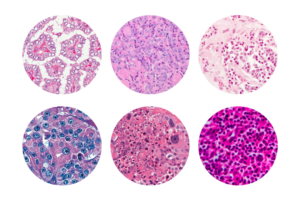Demystifying Thyroid Cancer Subtypes
There are several different types of thyroid cancer, each with its own characteristics and treatment approaches. In this article, we will discuss the most common types of thyroid cancer to help you understand them better.
Papillary Carcinoma
This is the most common type of thyroid cancer, accounting for about 80% of all cases. It typically develops in the cells that produce and store thyroid hormones. Papillary carcinoma usually grows slowly and has a relatively good prognosis. It is more common in younger individuals and women. It often appears as a single or multiple nodules within the thyroid gland.
Follicular Carcinoma
Follicular carcinoma makes up about 10-15% of thyroid cancer cases. It originates from the follicular cells of the thyroid gland. Follicular carcinoma tends to occur in middle-aged or older individuals, with women being more commonly affected. There is a slightly higher risk of this type spreading to distant sites, such as the lungs or bones, compared to papillary carcinoma. However, with appropriate treatment, the prognosis for most patients is favorable.
Medullary Carcinoma
Medullary carcinoma represents approximately 3-5% of thyroid cancers. Unlike papillary and follicular carcinoma, it arises from the parafollicular C cells of the thyroid gland, which produce the hormone calcitonin. It can be inherited as part of a genetic syndrome called multiple endocrine neoplasia (MEN) type 2A or 2B, but it may also occur sporadically in patients without any genetic syndrome. Medullary carcinoma tends to grow more aggressively and has a higher likelihood of spreading to nearby lymph nodes and distant organs. Genetic testing is often recommended for individuals diagnosed with medullary carcinoma to identify potential hereditary factors.
Anaplastic Carcinoma
Anaplastic carcinoma is a rare and aggressive form of thyroid cancer, accounting for only 1-2% of cases. It usually develops from pre-existing papillary or follicular carcinomas but can also occur without any pre-existing cancer. Anaplastic carcinoma grows rapidly, infiltrates surrounding tissues, and has a high potential for metastasis (spreading to other areas of the body). This type of cancer primarily affects older individuals and is more common in women. Due to its aggressive nature, anaplastic carcinoma is challenging to treat, and the prognosis is generally poor.
Thyroid Lymphoma
Thyroid lymphoma is a rare form of thyroid cancer that originates from the lymphatic tissue in the thyroid gland. It usually presents as a rapidly growing mass and is more common in older individuals. Thyroid lymphoma is often associated with Hashimoto’s thyroiditis, an autoimmune condition that causes chronic inflammation of the thyroid gland. Prompt diagnosis and appropriate treatment, including chemotherapy and radiation therapy, are crucial for managing this aggressive type of cancer.
Key Takeaways
It’s important to remember that each person’s situation is unique, and the specific type and stage of thyroid cancer will determine the most appropriate treatment plan. By understanding the differences between these types of thyroid cancer, you can work more effectively with healthcare professionals to develop a personalized treatment plan. Consulting specialists in surgery, endocrinology, and oncology is crucial to guide treatment decisions based on your specific needs and circumstances.

